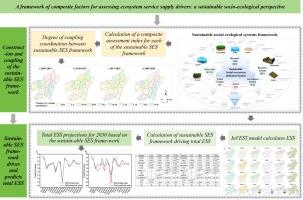A framework of composite factors for assessing ecosystem service supply drivers: A sustainable socio-ecological perspective
IF 7
2区 环境科学与生态学
Q1 ENVIRONMENTAL SCIENCES
引用次数: 0
Abstract
Studying the coupled relationship between social-ecological systems (SES) provides a more comprehensive understanding of the impact of human activity on ecosystems, thereby facilitating the formulation of more rational environmental protection policies. A deeper understanding of this relationship can promote the sustainable utilization and management of the environment. With its abundant natural resources, Ganzhou City represents the most typical ecological location in the southern hilly region of China. In this study, we constructed a sustainable framework for composite factors to analyze their effects on the ecosystem services supply (ESS). This framework emphasizes the positive roles assessment indicators such as water, forests, lakes, grasslands, and governance have on ESS, which are directly linked to the objectives of Sustainable Development Goal (SDG) 15, which include forest conservation, biodiversity maintenance, and water resource management. The results indicate that: (1) From 2005 to 2020, the overall ESS index in the central and western regions of Ganzhou showed a trend of being lower in the north and higher in the south, with areas outside the central and western regions showing a yearly increase. (2) Water, forest, lake, grassland, and governance indicators have a positive impact on the total ESS, while indicators such as mountains, sand, society, and actors have a negative impact. (3) From 2005 to 2020, the coupling coordination relationship in the central-northern and southern regions of Ganzhou gradually strengthened, with most areas shifting from a dysfunctional state to a low coupling state. By 2030, the total ESS index in counties such as Ningdu, Yudu, Huichang, Chongyi, and Xunwu is expected to decline. Some northeastern and southern regions are projected to show an upward trend by 2035. This study will significantly contribute to the realization of SDG 15, as it integrates closely related composite factors into a sustainable SES framework, by further delving into the factors influencing ESS and providing practical guidance for achieving SDGs.

评估生态系统服务供应驱动因素的综合因素框架:可持续社会生态视角
通过研究社会生态系统(SES)之间的耦合关系,可以更全面地了解人类活动对生态系统的影响,从而有助于制定更合理的环境保护政策。加深对这种关系的理解,可以促进环境的可持续利用和管理。赣州市自然资源丰富,是中国南方丘陵地区最典型的生态区位。在本研究中,我们构建了一个可持续的复合因子框架,以分析其对生态系统服务供给(ESS)的影响。该框架强调了水、森林、湖泊、草原和治理等评估指标对生态系统服务供给的积极作用,这些指标与可持续发展目标(SDG)15(包括森林保护、生物多样性维护和水资源管理)的目标直接相关。研究结果表明(1)从 2005 年到 2020 年,赣州中西部地区ESS 总指数呈现北低南高的趋势,中西部以外地区呈逐年上升趋势。(2)水、森林、湖泊、草原、治理等指标对ESS总指数的影响为正,而山、沙、社会、行为主体等指标对ESS总指数的影响为负。(3)2005-2020 年,赣州中北部和南部地区耦合协调关系逐步增强,大部分地区由功能失调状态转为低耦合状态。预计到 2030 年,宁都、于都、会昌、崇义、寻乌等县的 ESS 总指数将有所下降。预计到 2035 年,东北部和南部部分地区将呈上升趋势。本研究将密切相关的综合因素整合到可持续的生态系统服务框架中,通过进一步深入研究影响ESS的因素,为实现可持续发展目标提供实际指导,从而为可持续发展目标15的实现做出重要贡献。
本文章由计算机程序翻译,如有差异,请以英文原文为准。
求助全文
约1分钟内获得全文
求助全文
来源期刊

Ecological Indicators
环境科学-环境科学
CiteScore
11.80
自引率
8.70%
发文量
1163
审稿时长
78 days
期刊介绍:
The ultimate aim of Ecological Indicators is to integrate the monitoring and assessment of ecological and environmental indicators with management practices. The journal provides a forum for the discussion of the applied scientific development and review of traditional indicator approaches as well as for theoretical, modelling and quantitative applications such as index development. Research into the following areas will be published.
• All aspects of ecological and environmental indicators and indices.
• New indicators, and new approaches and methods for indicator development, testing and use.
• Development and modelling of indices, e.g. application of indicator suites across multiple scales and resources.
• Analysis and research of resource, system- and scale-specific indicators.
• Methods for integration of social and other valuation metrics for the production of scientifically rigorous and politically-relevant assessments using indicator-based monitoring and assessment programs.
• How research indicators can be transformed into direct application for management purposes.
• Broader assessment objectives and methods, e.g. biodiversity, biological integrity, and sustainability, through the use of indicators.
• Resource-specific indicators such as landscape, agroecosystems, forests, wetlands, etc.
 求助内容:
求助内容: 应助结果提醒方式:
应助结果提醒方式:


